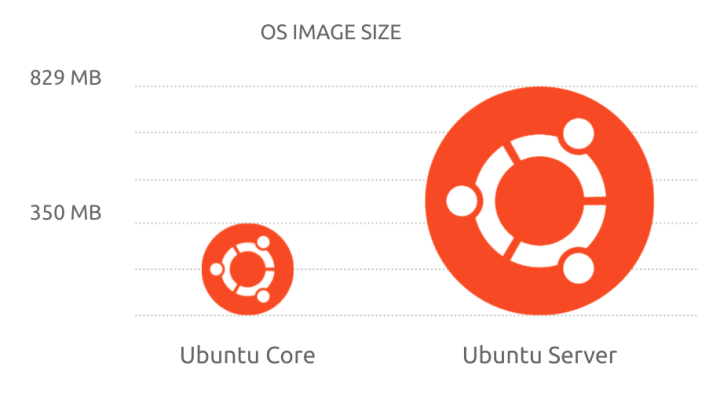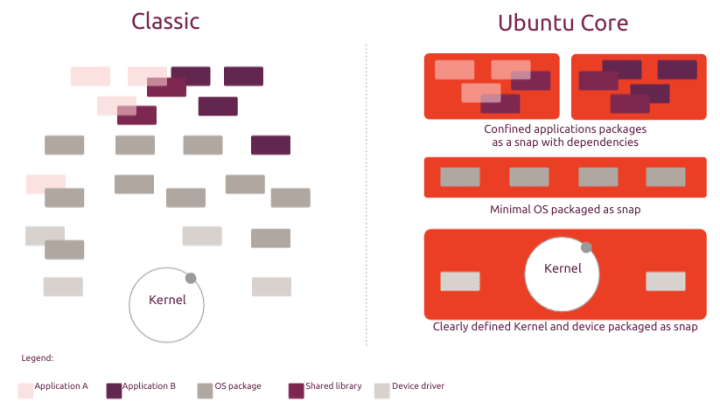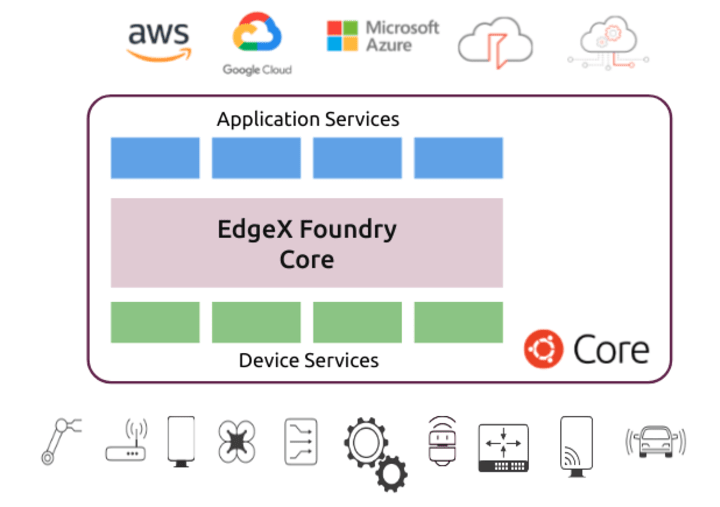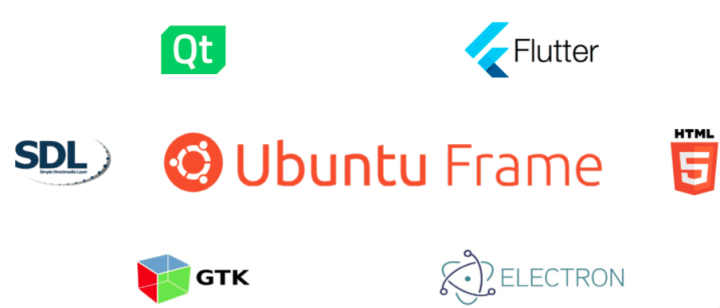Internet of Things and Ubuntu: 2021 highlights
Edoardo Barbieri
on 13 December 2021
Tags: Embedded Linux , Internet of things , IoT , Ubuntu , Ubuntu Core
With rising unit shipments and hardware spending, 2021 will go into the record books as a critical year in the ever-increasing adoption of connected devices. Ubuntu – the modern, open-source Linux operating system for the enterprise server, desktop, and cloud – is rapidly becoming the de-facto standard for Internet of Things ( IoT) devices. The following is not an exhaustive list of all the 2021 initiatives surrounding intelligent ‘things’ and Ubuntu, but an overview of some of the progress made at the intersection of those two landscapes.
Canonical, the publisher of Ubuntu, once again claimed its leadership in innovation by releasing Ubuntu Core images specially optimised for Intel’s purpose-built line of processors for IoT devices. Continuing the mission of supporting inventors, educators, and makers everywhere, Canonical also announced Ubuntu support for the newest Raspberry Pi Zero 2 W.
But enough with anticipating what is to come. With 2022 just around the corner, and IoT endpoints reaching an installed base of 25.1B units after growing at a 32% CAGR in the past four years, it is time to assess the pivotal role Ubuntu, the most widely deployed server operating system on the Internet, played in spurring such unprecedented growth [1].
Ubuntu optimised for Intel IoT platforms
To address the explosive blossoming of edge computing, Intel has developed a line of fit-for-purpose processors for IoT devices. The Intel Atom® X6000E, the Intel® Pentium®, the Celeron® N and the J Series Processors provide unparalleled levels of CPU and graphics performance with built-in security and functional safety.
As part of a vibrant ecosystem driving innovation at the edge, Intel and its IoT technology partners like Canonical collaborate to promote the deployment of high-performance embedded devices. Canonical, the commercial sponsor of Ubuntu, is at the cutting edge in the emerging categories of smart-gateways, self-driving cars, and advanced robots. Keeping at the forefront of innovation, in November Canonical released an optimised Ubuntu Core 20 image supporting Intel’s IoT processors.
However, it would be a mistake to consider the IoT as a cohesive market. Broadening the spectrum of supported use cases, the 11th Gen Intel® Core™ processors integrate AI capabilities while minimizing the jitter for low-latency deterministic computing to target mission-critical, real-time applications. Confirming Canonical’s presence at the bleeding edge of IoT workloads, Ubuntu Core (and Desktop) images specially crafted for Intel IoT processor families were also announced this year and are available for download.
Raspberry Pi Zero 2 W with Ubuntu support
Late in October, the folks at Raspberry Pi unleashed the Raspberry Pi Zero 2 W, squeezing unmatched performance into the six-year-old Zero form factor. Featuring a Broadcom BCM2710A1 SoC with a Cortex-A53 processor down-clocked at 1GHz, the Zero 2 W provides Bluetooth 4.2, BLE and 2.4HGz wireless connectivity. Thanks to the performance boost compared to the Zero W, Ubuntu Server and Core seamlessly run on the Zero 2 W, supporting inventors, educators, and eccentric tinkerers everywhere. By porting Ubuntu to the Raspberry Pi world, Canonical helps bring the best and the latest in open source to digital makers. Priced at $15, you can get Ubuntu on the cheapest quad-core Pi available today!

Ubuntu on adaptive Xilinx SoCs
Late this December, Canonical and Xilinx strengthened their partnership to spur the adoption of enterprise-grade Linux in the world of hardware-adaptive SoCs.
Xilinx, the inventor of the FPGA, develops highly flexible processing platforms promoting breakthroughs across the entire computing landscape. Among those, the adaptive Kria System-on-Modules (SOMs) are the perfect platform for next-gen robotics and comprise pre-built hardware and software with production-ready accelerated applications. Similarly, the Zynq UltraScale+ is a heterogeneous multiprocessing MPSoC at the avant-garde of innovation covering embedded applications from 5G wireless to the industrial internet of things (IIoT).
At the end of 2021, Canonical released Ubuntu 20.04.3 LTS images for Xilinx Zynq UltraScale+ MPSoC-based evaluation boards and Kria SOMs, ensuring the latest features on Xilinx hardware are available with a standard Ubuntu image. You can read here the announcement covering Canonical teaming up with Xilinx to accelerate the development of adaptive SoCs.
Canonical at Embedded World 2021
Earlier this year, Canonical sponsored Embedded World 2021 once again. In a keynote entitled “Ubuntu Core for industry 4.0: Bosch Rexroth’s path to complete automation”, Bosch Rexroth highlighted its embrace of open source and open architectures to reap the benefits of Industry 4.0.
Bosch Rexroth, among the premier suppliers of drive and control technologies, selected Ubuntu Core for their app-based platform ctrlX AUTOMATION. Leveraging Ubuntu Core and snaps, ctrlX AUTOMATION enables industrial machine manufacturers to adopt modern CI/CD and DevSecOps approaches to deliver applications on edge devices in a conventional OT environment. Furthermore, developers using the ctrlX AUTOMATION platform now have the freedom to pick their language of choice, be that C, C++, Python, Javascript, or Go, instead of being dependent on PLC specialists and programming languages like IEC 61131, or G-Code in an industrial setting with the software decoupled from the hardware. You can read the original announcement here.
An introduction to Ubuntu Core 20
Unless you lived under a rock, you know Ubuntu Core is the new standard for embedded Linux. Let us remind you why.
Ubuntu Core is the flavour of Ubuntu for IoT devices and embedded systems with a minimal footprint. Ubuntu Core automatically confines applications and is updated transactionally, providing worry-free updates and rollback capability. Earlier this year, Canonical delivered a webinar highlighting the key features of the 20.04 LTS release. If you want to focus on your value-add software and have a peace-of-mind solution handling the remaining parts of the ecosystem (updates, security, maintenance, etc.) for you, check it out!

A technical introduction to Ubuntu Core 20
Chances are high that you have already heard of Ubuntu Core and how it revolutionizes the embedded landscape. But do you know why? Built on Snaps, the universal Linux packaging format, it delivers stronger resiliency and better security, precisely what developers have come to expect from Ubuntu. Applications are provided as snaps, enabling developers to control the version delivery and dependent software stack.
Delta, over-the-air updates conserve bandwidth and are patched with the existing snaps to create a new version on disk, mitigating data corruption as the system maintains the original data and snap before the upgrade. Furthermore, the kernel, the rootfs, and any application on top are transactionally updated, allowing for faster, more reliable updates. If you are ready to delve deep into the atomic, reversible software update capabilities of Ubuntu Core, check the technical webinar released earlier in March this year.

Virtually all developers know Ubuntu is the default OS for public cloud workloads. It should by now be clearer that Ubuntu has a prominent presence in a wide range of computing technologies. What else has happened in 2021 at the intersection of the IoT and Ubuntu landscape?
IoT fleet management for digital signage with Ubuntu Core
Screenly is on a mission to turn any screen into a powerful digital sign by displaying images, videos, live web pages, and more in beautiful 1080p Full HD resolution. Powering over 10,000 screens across 75 countries, they understand full-well the importance of adopting a security-first approach in the digital signage space.

The vision? To make secure and reliable digital signage accessible to everyone. The solution? To keep deployed devices up-to-date via remote updates with fixes to the security vulnerabilities.
Screenly adopted Ubuntu Core and the IoT App Store, perfectly fit to deliver the vision as frictionlessly as possible. As of today, the San Francisco-based company leverages Canonical’s established expertise and solutions to rapidly deploy over-the-air (OTA) software updates with the latest security fixes and features. Read the 2021 case study to understand how Screenly innovates IoT fleet management for secure digital signage with Ubuntu Core and an IoT App Store. And if you are eager to get started with digital signage and smart displays on Ubuntu, head over to this page.
Run edge applications with EdgeX on Ubuntu Core
What is needed to build successful IoT/edge devices deployed at scale? Developers and makers want to focus on their application, trusting a reliable and secure underlying framework for the whole life of their devices in the field. EdgeX Foundry, under the umbrella of the Linux Foundation, provides a developer-friendly software framework with C and Go SDKs for building edge computing applications, enabling them to do just that while reducing time-to-market. Its modularity and flexibility facilitate interoperability between devices and applications without vendor constraints. The second piece required by IoT/edge devices for large-scale deployments is a reliable operating system providing all needed security features and services to port the software to the chosen hardware and keep devices secure and up-to-date.
As part of the EdgeX Foundry Adopter Series, Canonical shared a presentation with the community earlier this June on running edge computing applications with EdgeX on the enterprise-grade operating system Ubuntu Core. EdgeX speeds up the time-to-market for edge solutions by offering a modular and scalable solution for reference services from device-data integration and normalisation to edge intelligence. It supports IoT cloud data services and the most popular communication protocols, such as MQTT, Modbus, Bacnet, and BLE. Later this year, Canonical delved into deploying EdgeX Foundry as a snap on Ubuntu Core. To get started with EdgeX as snaps, check this tutorial.

Ubuntu Frame, the foundation for embedded displays
Finally, this year Canonical also announced the release of Ubuntu Frame, the foundation for embedded displays. Looking to get started with graphical applications on Ubuntu Core? Based on the latest Wayland protocol, Ubuntu Frame is the next-gen graphical server for edge devices, digital signage solutions, and any embedded product requiring a graphic output. Compatible with a wide variety of applications built with GTK3/4, Qt5/6, Flutter, Electron, and SDL2, Ubuntu Frame provides an out-of-the-box secure solution to develop and deploy fully interactive applications. If you are interested in learning more about Ubuntu Frame, check this webinar or download its product brief.

Conclusion
To say 2021 was the year Ubuntu, the most secure and trusted enterprise-grade OS, affirmed its de-facto presence in the embedded and IoT spheres is a generous but fair assessment.
Among its latest releases, Canonical published Ubuntu images supporting the newest embedded silicon from Intel with a focus on IoT features to power the next generation of edge devices. Further, in 2021 the just-released Raspberry Pi Zero 2 W, the cheapest quad-core Pi available today, saw immediate Ubuntu support. From showcasing the path from community-maintained build systems like Buildroot and Yocto to enterprise-grade embedded Linux to Xiaomi’s CyberDog robot running Ubuntu, many other initiatives occurred in 2021 but didn’t make it into this round-up. And if you think 2021 was quite a year for Ubuntu and IoT, hold on tight as Canonical is fully committed to making 2022 its best so far.
Find out all you need to know about building and managing IoT and embedded devices using Ubuntu right now! You can also get started with this step-by-step tutorial showcasing how to boot Ubuntu Core or talk to us if you are thinking about using Ubuntu Core for your next Internet of Things project.
Open source is what we do
We believe in the power of open source software. Besides driving projects like Ubuntu, we contribute staff, code and funding to many more.
Newsletter signup
Related posts
Canonical’s Ubuntu to be supported on NVIDIA Jetson Thor
Canonical commits to Ubuntu long-term support and security patching for NVIDIA Jetson Thor, bringing real-time performance, out-of-the-box compatibility, and...
What are our partners building for device makers? Explore the highlights from Ubuntu IoT Day Singapore
Our first Ubuntu IoT Day in Southeast Asia – and our first ever event in Singapore! It was long overdue, as several attendees were quick to remind us. Ubuntu...
Ubuntu IoT Day in Singapore – Unlock compliant and scalable innovation in edge AI
Singapore | May 27, 2025 | Full-day event How do you build robust, performant edge AI infrastructure? This is the question organizations are asking themselves...
